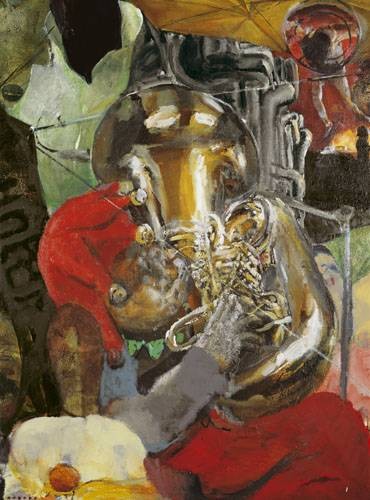Bernhard Heisig
The Rage of Pictures
11 Jun - 25 Sep 2005

Bernhard Heisig, Mechanismen des Vergessens, 1981 (Detail), Öl auf Leinwand, 151,5 * 242 cm, Landesmuseum für Kunst und Kulturgeschichte Oldenburg
© VG Bild-Kunst, Bonn, Foto: U. Gerstenberger / Museum der bildenden Künste Leipzig
© VG Bild-Kunst, Bonn, Foto: U. Gerstenberger / Museum der bildenden Künste Leipzig
On view from 11 June to 25 September, 2005 at the K20 Kunstsammlung Nordrhein-Westfalen on Grabbeplatz will be the exhibition The Rage of Pictures by the artist Bernhard Heisig.
Sixty years after the end of World War II, and on the occasion of Heisig’s 80th birthday, approximately 70 paintings and 60 drawings and graphic works by this major artist — reflecting a spectrum of experiences spanning ca. 50 years — will be on public view. Suggestively and with sovereignty, his oeuvre thematizes the trauma of German Fascism. Familiarly, Heisig is a prominent member alongside Wolfgang Mattheuer and Werner Tübke of the school of Leipzig painters, which elaborated a viable alternative to the aesthetic doctrines of the GDR while earning substantial international acclaim. Heisig has entitled the present exhibition “The Rage of Pictures.” Why so? Perhaps because these images tell of a monstrous rupture within civilized existence, one that marked recent German history with the horrors of Nazism and world war. This rage, then, is directed against a monolithic system of blind irrationality that brought incalculable misery to the world, and against our collective failure to prevent this global catastrophe. It is an understandable and perhaps inevitable fury against the perpetrators and their countless collaborators, cloaked in silent passivity, a fury, meanwhile, that is displaced by sadness and shame when we recall the victims. Always on a highly demanding artistic plane, Heising submits to a perpetually unconcluded labor of memory that confronts viewers with its nightmarish subject matter in continually novel variations and permutations.
Sixty years after the end of World War II, and on the occasion of Heisig’s 80th birthday, approximately 70 paintings and 60 drawings and graphic works by this major artist — reflecting a spectrum of experiences spanning ca. 50 years — will be on public view. Suggestively and with sovereignty, his oeuvre thematizes the trauma of German Fascism. Familiarly, Heisig is a prominent member alongside Wolfgang Mattheuer and Werner Tübke of the school of Leipzig painters, which elaborated a viable alternative to the aesthetic doctrines of the GDR while earning substantial international acclaim. Heisig has entitled the present exhibition “The Rage of Pictures.” Why so? Perhaps because these images tell of a monstrous rupture within civilized existence, one that marked recent German history with the horrors of Nazism and world war. This rage, then, is directed against a monolithic system of blind irrationality that brought incalculable misery to the world, and against our collective failure to prevent this global catastrophe. It is an understandable and perhaps inevitable fury against the perpetrators and their countless collaborators, cloaked in silent passivity, a fury, meanwhile, that is displaced by sadness and shame when we recall the victims. Always on a highly demanding artistic plane, Heising submits to a perpetually unconcluded labor of memory that confronts viewers with its nightmarish subject matter in continually novel variations and permutations.
